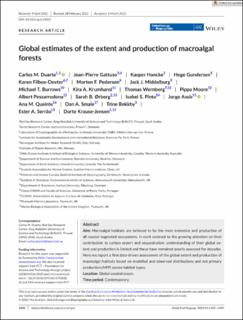Global estimates of the extent and production of macroalgal forests
Duarte, Carlos M.; Gattuso, Jean-Pierre; Hancke, Kasper; Gundersen, Hege; Filbee-Dexter, Karen; Pedersen, Morten Foldager; Middelburg, J.J.; Burrows, Michael T.; Krumhansl, Kira A.; Wernberg, Thomas; Moore, Pippa J.; Pessarrodona, Albert; Ørberg, Sarah; Pinto, Isabel Sousa; Assis, Jorge; Queirós, Ana M.; Smale, Dan A; Bekkby, Trine; Serrão, Ester A.; Krause-Jensen, Dorte
Peer reviewed, Journal article
Published version
Permanent lenke
https://hdl.handle.net/11250/3016942Utgivelsesdato
2022Metadata
Vis full innførselSamlinger
- Publikasjoner fra Cristin - NIVA [2160]
- Scientific publications [1172]
Sammendrag
Macroalgal habitats are believed to be the most extensive and productive of all coastal vegetated ecosystems. In stark contrast to the growing attention on their contribution to carbon export and sequestration, understanding of their global extent and production is limited and these have remained poorly assessed for decades. Here we report a first data-driven assessment of the global extent and production of macroalgal habitats based on modelled and observed distributions and net primary production (NPP) across habitat types. Here we apply a comprehensive niche model to generate an improved global map of potential macroalgal distribution, constrained by incident light on the seafloor and substrate type. We compiled areal net primary production (NPP) rates across macroalgal habitats from the literature and combined this with our estimates of the global extent of these habitats to calculate global macroalgal NPP. We show that macroalgal forests are a major biome with a global area of 6.06–7.22 million km2, dominated by red algae, and NPP of 1.32 Pg C/year, dominated by brown algae. The global macroalgal biome is comparable, in area and NPP, to the Amazon forest, but is globally distributed as a thin strip around shorelines. Macroalgae are expanding in polar, subpolar and tropical areas, where their potential extent is also largest, likely increasing the overall contribution of algal forests to global carbon sequestration.

